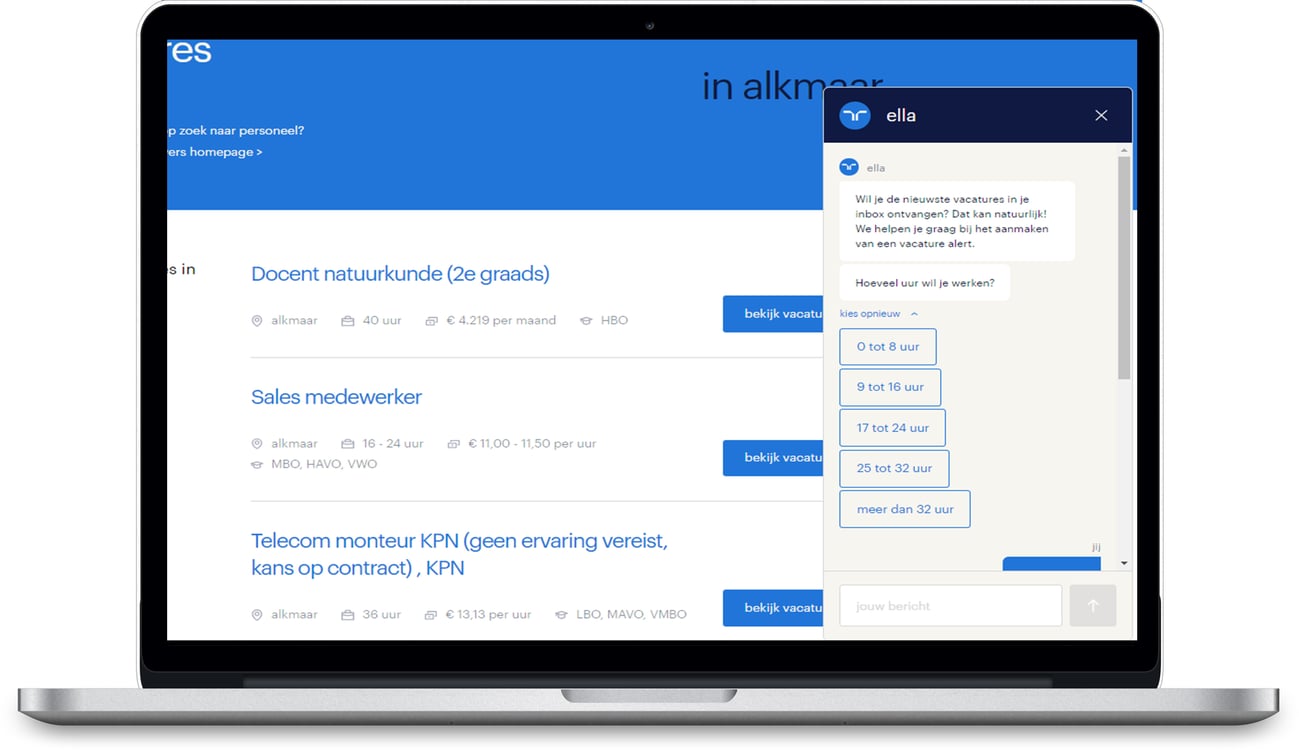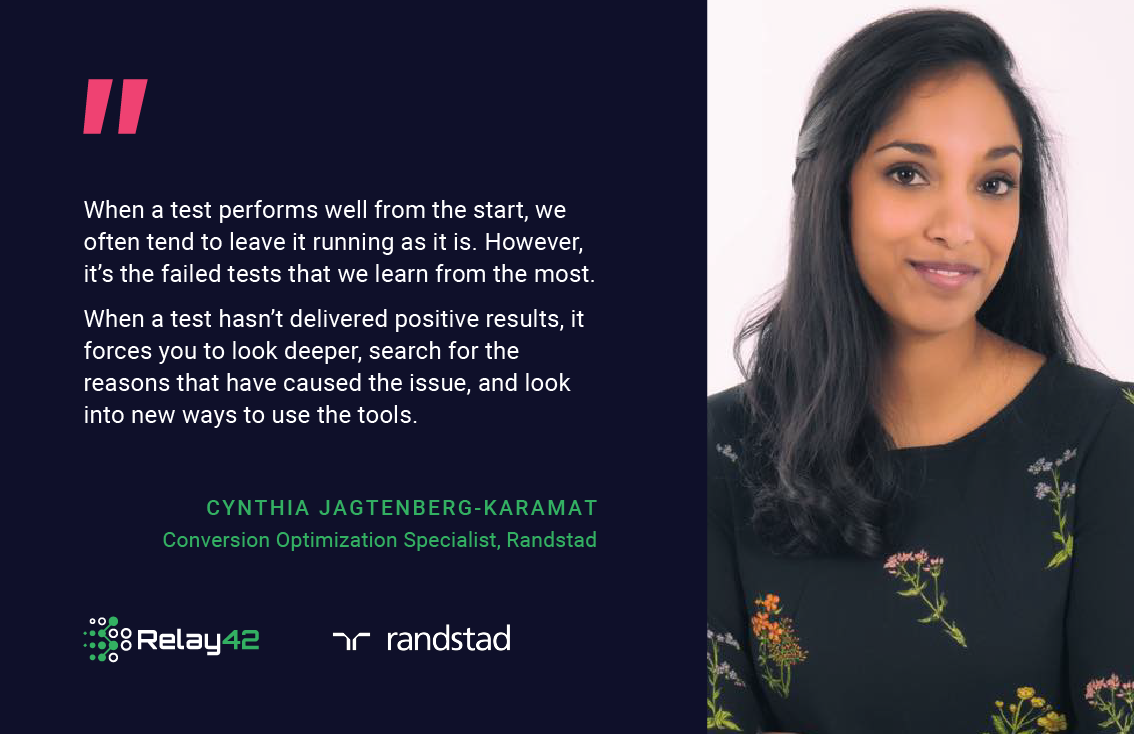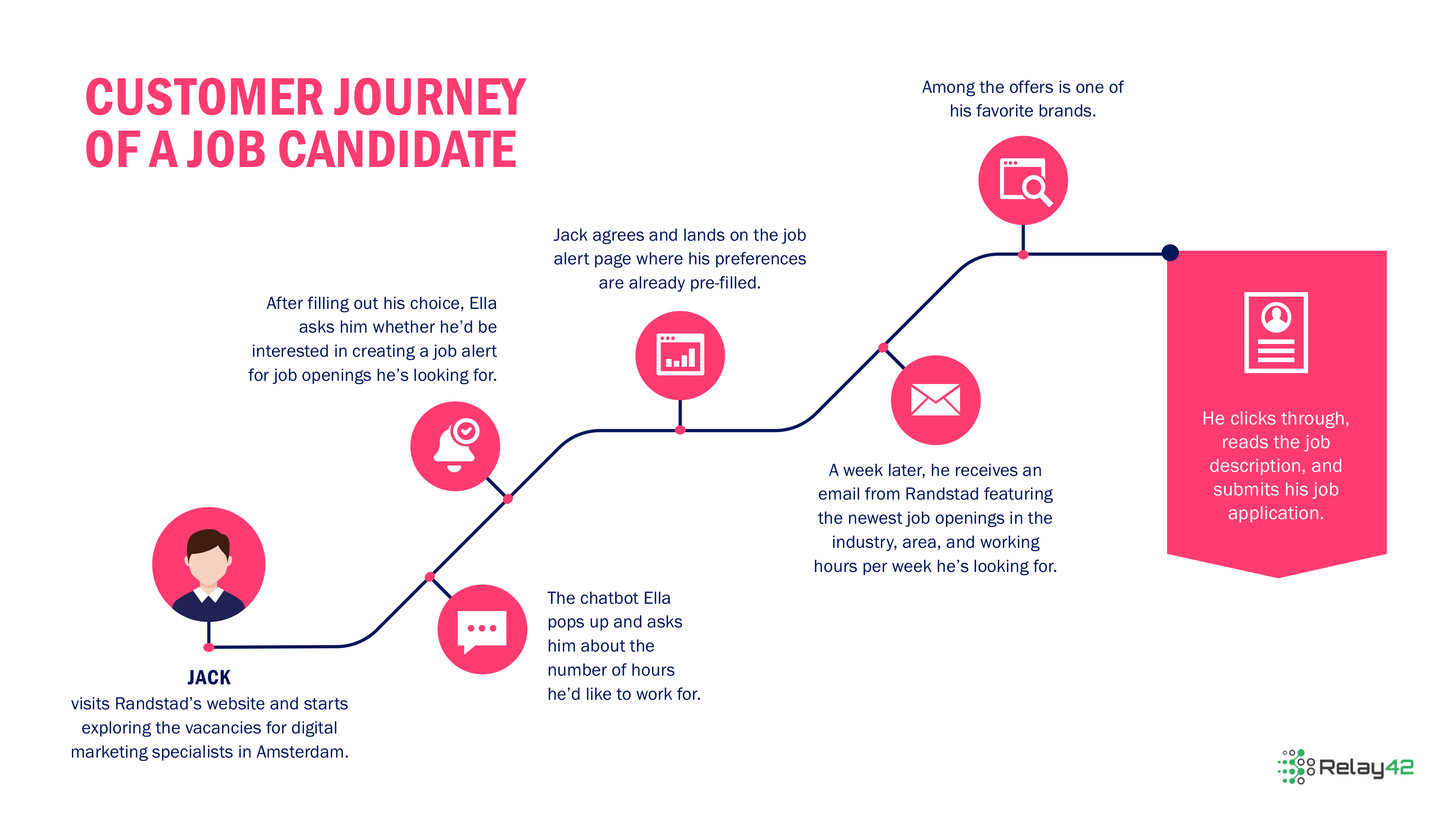Customer Data Platform Case Study
How Randstad improved the customer experience with Relay42

+273%
With Relay42, Randstad achieved a 273% increase in vacancy alerts
4X Increase
With Relay42, Randstad generated 4X more visitors to its vacancy alerts
The Recruitment CDP Use Case for Randstad

Cynthia Jagtenberg-Karamat
Conversion Optimization Specialist at Randstad
The online marketing team of Randstad asked themselves how they could improve the customer experience and help their visitors find what they’re looking for quickly and efficiently.
With the use of the Relay42 platform and their chatbot system, they quadrupled the number of visitors to the vacancy alert page and increased the number of vacancy alerts by 272.75%.
To tell us more, we sat down with Cynthia Jagtenberg-Karamat, Conversion Optimization Specialist at Randstad.
Having almost ten years of experience with conversion rate optimization, Cynthia has been part of Randstad's Online Team for the past four years, helping the team increase its effectiveness through actionable insights and high-performing data-driven use cases.
Increase in vacancy alerts
More visitors to the vacancy alert page
Driving agile transformation
Randstad’s mission is to help people secure rewarding jobs and stay relevant in the ever-changing world of work. Their ultimate goal is to touch the work lives of 500 million people by 2030. To achieve this ambition, the digital marketing team is currently in the process of agile transformation. This implies closer collaboration between the different marketing and IT specialists and working in multi-disciplinary teams. Becoming data-driven and being able to test new technologies quickly is therefore crucial in ensuring that they can provide the best possible service to their customers.
Centralizing the customer service touchpoints
Randstad wants to empower their customers so that they can find the right job for them in a way that's fast and efficient. To improve their digital customer service, the online marketing team decided to centralize their communication via the website, by driving the customer questions to their chatbot service, Ella.
In the past, the customer service channels included dozens of phone numbers and hundreds of email addresses. Since live chat via the chatbot was already a customer service touchpoint, the marketing team saw it as the ideal solution that could serve as a central tool for helping the candidates on their journey.
With the chatbot, the marketing team aimed to encourage candidates to look for the answers to their questions on the Randstad website themselves, and only when a question was too complex or too specific, they would be sent to a customer support agent via the live chat.
The customer support agent would then be able to see the whole history of the chat so that they could understand exactly what the candidate is looking for and help them quickly. By providing the history of the chat, Randstad was able to significantly reduce the average time for a conversation — from an average of 8 minutes down to an average of 5 minutes per conversation.

Understanding what job candidates really need
A year after implementing the current setup, the chatbot was able to answer about 75% of the job candidates’ questions and the online marketing team was ready to take the next steps.
Their main question was: How can we use the chatbot to improve the customer experience on the website?
As a starting point, the marketing team decided to proactively trigger the chatbot to visitors who have seen at least five vacancy pages. The chatbot would simply ask the candidate if they needed any assistance. This experiment, however, didn’t produce the results that the team was hoping for. The feedback they received from candidates was that the chatbot was appearing too frequently and it was interrupting their process. People just weren’t ready to interact with the chatbot.
While the results were not what the team expected, this experiment provided valuable insights into the candidates’ behavior and needs. Instead of giving up, Cynthia used these insights and started exploring new ways in which the chatbot would truly help the candidates.

Reaching the customers at the right moment
For the second chatbot experiment, Cynthia focused on the job alert page. The job alert allows candidates to receive notifications to their email about a job they’re looking for, based on their personal preferences: job function, location, education level, and maximum working hours per week.
By creating an alert, a candidate is always up to date with the newest job openings and can respond quickly to the opportunity. For Randstad, this means that they can keep in touch with the candidate, by providing them with personalized, relevant information.
As a starting point, Cynthia looked into the analytics of the job alert page and investigated the paths that candidates were coming from, before reaching the page. She then discovered that there were a couple of paths (hot pages) where visitors were coming from.
After identifying the most common paths, she turned to Frank Verburg, a Technical Web Analyst and a Relay42 expert. With the Relay42 Platform, Frank created segments of visitors who landed on these paths and set up rules that would trigger the chatbot to these visitors.
Then Cynthia asked the chatbot’s content manager to create a dialogue in the chatbot tool in the tone of voice of Randstad. Based on insights from previous A/B tests on the website, the team knew that visitors would be more willing to engage with Ella when the tool included an interactive element. With this in mind, they added the first question of creating a job alert directly to the chatbot dialogue, and only after that, they showed the link to the job alert page.
This time, the use case exceeded the expectations. After comparing the periods before the launch of the experiment, the team measured a quadrupled number of visitors to the vacancy alert page and a 272.75% increase in the number of vacancy alerts. They also found out that 12.15% of all website visitors interacted with Ella and from this group, 44.32% clicked on the "Create a vacancy alert" call-to-action button.

Creating mutual value — the key to cross-team collaboration
For a multinational organization such as Randstad, working in multi-disciplinary teams can be both exciting and challenging. Each team has its goals and KPIs, and asking a colleague for support can be a lengthy process.
As a specialist in conversion optimization, Cynthia often needs to collaborate with the IT team and throughout the years she has learned how to turn this collaboration into a mutually beneficial relationship:
“In the beginning, I was struggling to work with the IT team. They were always really busy and their planning was done months earlier so my tasks would come at the end of their backlogs,” explains Cynthia.
To bring the two teams closer together, she organized a meeting during which the IT team could share the projects that they were working on. After this session, Cynthia realized that there were many overlapping areas between the two teams and suggested helping the IT team in these common projects. From that moment on, the collaboration began to flourish. Instead of pushing her own projects, the CRO and the IT team were working towards a common objective, which strengthened both teams and accelerated the process of launching new use cases.

Cynthia’s pro-tip for marketers
'Every beginning is challenging. Keep in mind that when you implement a new tool like a chatbot, you need to give your audience time to get used to it as well.
Don't give up if something doesn't show immediate success. Just keep on working towards your goal, looking into the data, analysing, and learning from it!''
Driving Marketing Growth Value for Inspiring Brands

+115% Conversion Rate Uplift on Brand Search
Levi's Strauss & Co.

+25% In revenue via email marketing
KLM Royal Dutch Airlines
.png?width=750&height=500&name=Untitled%20design%20(28).png)
+272.75% Increase in the number of vacancy alerts
Randstad
.png?width=750&height=500&name=Untitled%20design%20(25).png)
+86% Increase in leads
Vattenfall
.png?width=750&height=500&name=Untitled%20design%20(27).png)
+90% Increase in requests for information
Mazda Netherlands
See Relay42 in Action
Experience a first-hand tour of the Relay42 Customer Data Platform with one of our consultants


